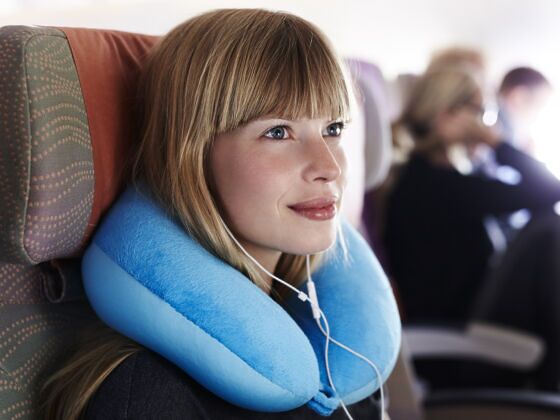The first time I flew, I was 15 years old. My dad had secretly organized a five-day father-daughter trip to London the summer I graduated from junior high, and it involved flying from my home airport of Nantes in France to London Gatwick. On the day of our departure, I remember boarding the plane, sitting next to my dad, putting my things away, and buckling my seat belt. I was not nervous. That is, until the aircraft started accelerating down the runway for takeoff. That’s when all hell broke loose. I took my father’s hand and squeeze it until we touched down in the UK. I was frozen with fear for the entire one-hour flight. When we got out of the plane, I recall turning to my dad and saying: “I’m not doing this for the way back.”


How Hypnotherapy Helped Me Get Over My Debilitating Fear of Flying
We did, in fact, fly back. My father had purchased return flights and there was no way the plan was going to be altered just because I had the jitters. Surprisingly, I don’t remember the return flight at all. What I know, however, is that for the next 20 years, every flight I took was like a living nightmare. The terror I experienced when flying was like no other emotion I have ever felt. It was uncontrollable, filled with tears, labored breathing, and tremors.
Between the ages of 15 and 23, I traveled around Europe extensively and left my home country to live in Ireland, yet I only flew three times. Among many of the convoluted trips that I concocted to avoid flying: I traveled from Paris to St. Petersburg by train, which took three days; I went back and forth between Ireland and France multiple times per year by 20-plus hour ferries, trains, and buses; and I drove a little Fiat hundreds of miles across Germany, Austria, Slovenia, Croatia, and France.
And then, at age 23, I met my partner, a Canadian who lived in the mountains of British Columbia, i.e. an ocean and a continent away from me. Transatlantic trains and bus services being what they are, I had to fly.
Despite an average of six to 10 flights per year for over 10 years (mostly between Canada and France), my fear never subsided. Medication, controlled breathing, worry stones — nothing helped. The kind travelers seating beside me, who held my hand and whispered reassurances, never failed to ask me “Is it your first flight?”, to which I always responded, “No, I do this all the time.” The look on their faces said it all: The girl is a masochistic nut.
The fact that, at age 27, I started working for a travel publication added to the inconvenience and the absurdity of my fear.
I finally sought out the help I needed in 2018, at the age of 32. A couple of days after landing in Canada after after some time spent in France, I opened my laptop, looked for a registered psychologist who practiced hypnotherapy, and made an appointment. I’d had enough and I was ready to change the way I lived.
Judging by what I’d read former smokers say about hypnosis, I had imagined that a few hypnotherapy sessions was going to fix me up for good. Of course, it did not go that way, because psychology isn’t magic. While the impetus for going to therapy was my fear of flying, what my psychologist and I delved into during the 15 or so sessions we had together went beyond flight anxiety. Because fear of flying does not exist on its own in your mind, it’s linked to other experiences and memories, all of them reacting off each other. All of them needing to be tackled.
In total, I had three hypnotherapy sessions, and as many Eye Movement Desensitization and Reprocessing (EMDR) sessions. The hypnotherapy was recorded so I could practice on my own at home and even in the airplane, which I did, no matter how silly I felt. Because, yes, you can self-hypnotize.
Hypnosis for the purpose of therapy is a lot less theatrical than what most of us have in mind. There’s no pocket watch swinging from side to side and nobody is making you cluck like a chicken. During my hypnotherapy session, all I had to do was sit comfortably, close my eyes, and listen to my therapist. She had prepared a script, suited to my needs, and she was delivering it in a slow, quiet way. During hypnosis, I was never asleep and was always aware of what was going on, but I also felt separated from the world in a very subtle way, as if I was inside a soap bubble. It certainly was not scary and I never felt like I was losing control of my situation.
The results of all this work were not immediate and not 100 percent positive. I had some good flights and some bad flights, but I did feel very transformed. Therapy led me to make enormous and very much needed changes that eventually allowed me to live a better life with less anxiety.
It took around three years after my last therapy session to feel at ease about being in the air. While it may seem like a long time, it was worth the wait. I can sit through a 10-hour flight punctuated with turbulence without crying, trembling, or hyperventilating, and I don’t need the help of my seat mate or a flight attendant to calm down. I can also ride in cable cars, something I never thought I’d be able to do.
Getting over your fear of flying requires a lot of discomfort and a good amount of money, but first and foremost, it requires a willingness to change and tackle more than just one fear. But if I did it, me, one of the most anxious flyers the world had ever created, you can do it, too.